Soccer exercises for u14
3 variants:
- Pass with handball and then rounding left or right
- Pass with turn through pass to the left or right
- Pass with 2 bounces and then finish left or right

Conditional finishing with different match situations
Finishing form focused on finishing on goal.
The aim is to finish at a high tempo, while also addressing the conditional aspect
Exercise:
Finishing form focused on finishing on goal.
The aim is to finish at a high tempo, while also addressing the conditional aspect
Exercise:
- A dribbles to edge 16
- A finishes
- A sprints back to middle pylon and asks ball to B
- B gives ball to A
- A rebounds to B
- B Finishes
- A sprints to 3rd pylon and asks ball to C
- C rebounds ball to A
- A gives deep ball to C
- C sprints to the side
- C passes ball across the ground
- A-B change positions
- A-B work off
Coaching:
- start on time
- play hard on team-mate
- move on immediately
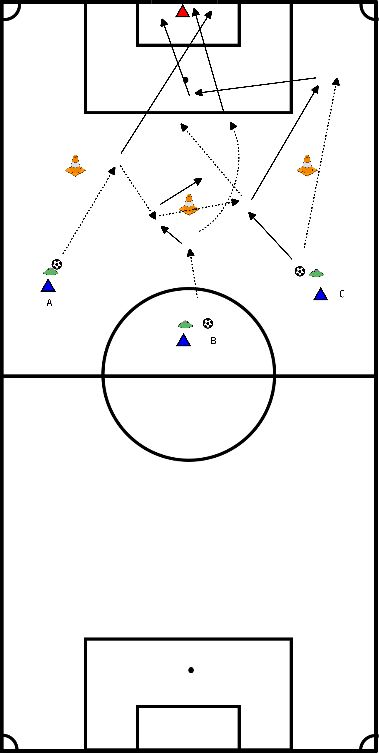
Goal:
- Improve building from behind
Contents:
- Improve building from behind
Contents:
- A does for action and asks for the ball from B
- B plays ball to A
- A plays ball to C
- D starts to run forward
- C passes ball in the run to D
- D finishes on the small goalmouth
- A = 6
- B = 3
- C = 3-4
- D = 2
Coaching:
- Communicate with your players
- Keep moving continuously
- See where your fellow players are standing
- Run on time
CAUTION!!!
Exercise is done in two groups so there is no need to stand still for long periods of time!
- Communicate with your players
- Keep moving continuously
- See where your fellow players are standing
- Run on time
CAUTION!!!
Exercise is done in two groups so there is no need to stand still for long periods of time!

- Distances:
- Rectangle of 15 by 5 meters.
- Pawns B and C 5 meters apart.
- Both 2.5 meters from side and 5 meters from A and D.
- Duration: 10 min.
- After 5 min change direction
Explanation:
- A plays into B
- B drops the ball to C
- C passes to D
- The moment the ball reaches D, A has to be there to make the handball.
- D bounces to A and runs straight through to be played in again.
- A rebounds to D and D rebounds to E.
- E takes ball to starting point.
- Running lines: A becomes B, B becomes C etc.
Points of attention:
- Tight balls by hitting ball in heart, body slightly over ball.
- B must drop the ball on C slightly to outside so that there is a free pass line to D.
- A must time that she/he is present at the right time for the handball with D.
- If she/he is too early and has to wait too long it means in the match that there is opponent in her/his back.
- Is she/he too late D has to wait it means in the match that the opponent can put pressure on D.
- To maintain concentration make sure that at point A the ball is not played until everyone is in place.
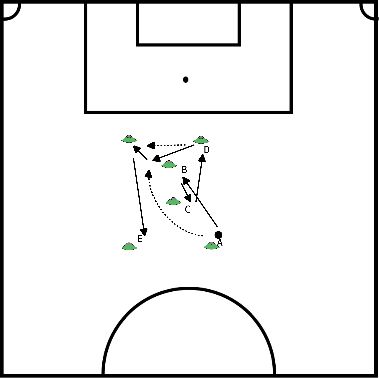
Description
- Players start at pylons
- Balls are in the middle
- Players kick in place
- When trainer calls, players go toward balls, 2-pairs at 1 ball
- Coach calls left and right, players go to that side
- When trainer calls ball, you have to take the ball with your hands
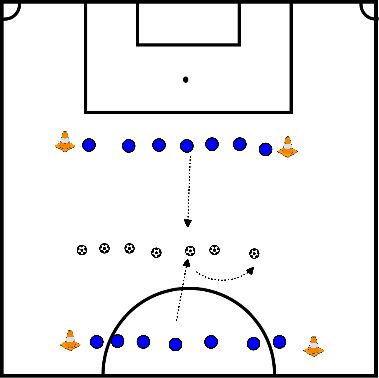
- Player blue on the back line plays the ball diagonally to player red across from him
- Player red on the back line plays the ball diagonally to player blue across from him
- Then the players try to defend by putting high pressure
- Players who received the ball try to score
- Player red on the back line plays the ball diagonally to player blue across from him
- Then the players try to defend by putting high pressure
- Players who received the ball try to score
Situation 2
- As soon as one of the attackers has scored, and the other has not yet scored, then they switch immediately, making the situation 1 against 1 / 2 against 2
Coaching:
- Switching moment immediately at ball loss or goal
- Direct pressure on the ball in man-more situation

This Exercise can be performed on both sides:
- Good handball
- Tight pass after it
- Lay wide edge 16
- After this round off on goal.
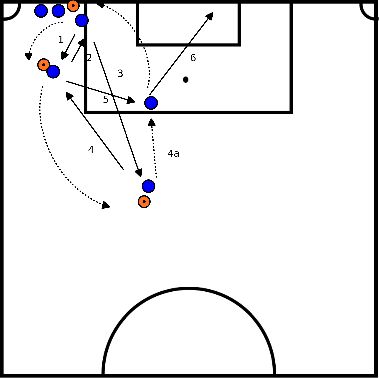
1st exercise:
- Player A plays the ball in to B and runs to B's position.
- Player B stands open turned, takes it and passes it to Player C and so on.
- Point of attention playing in:
- the ball must be hit in the middle so that it stays low.
- The correct technique for this is to lift your shooting leg slightly.
- Passing point:
- The player who accepts the ball should not be facing the ball with his or her body, but turned "open". You create this by positioning your body towards the player you are passing to and with your eyes on the ball.
- Playing around clockwise, the ball is taken on with the left and I play on with the right.
- In the other direction take on with the right and play on with the left.
- If you notice it's too easy, first increase the pace. Then to make it more difficult you can take out the assumption and they have to pass the ball directly.
2nd exercise:
- Player B asks for the ball.
- Player A plays into player B.
- Then B then drops the ball to player A after which he passes it back to player C.
- Player C then drops it to player B and then player B plays it diagonally to player D and so on.
Points of attention:
- The player who plays the ball in must move on after the play-in so that he can ask for the ball, in the middle, between the pawns
- Not further because then the effect is gone with the cross pass.
- The player who rebounds runs around his own pawn to ask for the ball again in the middle.
- This player must make the correct turn when rebounding so that he keeps his eyes on the ball.
- His turn should be short toward the box and not off the play.
In both drills after 8 minutes, change directions of play.
Clockwise passes with right leg, counterclockwise passes with left leg.
Clockwise passes with right leg, counterclockwise passes with left leg.
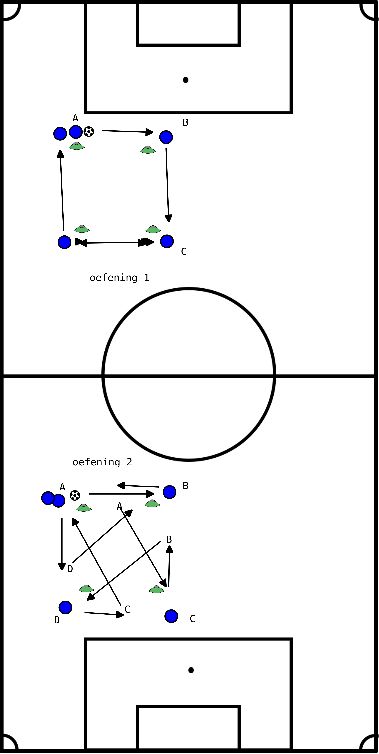
1st exercise:
- Player A plays the ball in to B and runs to B's position.
- Player B is open turned takes it and passes it to Player C and so on.
- Focal point 1 playing in: the ball must be hit in the middle so that it stays low.
- The correct technique for this is to lift your shooting leg slightly.
- Focal point 2 receiving: The player who has to receive the ball should not be facing the ball but rather, as they say, turned open. You create this by positioning your body towards the player you have to pass to and your face is facing the ball. Playing the ball around clockwise, the ball is taken on with the left and I play on with the right. other way round take on with the right and play on with the left.
- If you notice that it is too easy, first increase the tempo. If that also proves too easy then you take out the takeover and they have to pass the ball directly.
2nd exercise:
- Player B asks for the ball, player A plays into player B. Then B drops the ball to player A who then passes it on to player C.
- Player C then drops it to player B and then player B plays it diagonally to player D and so on.
Points of attention:
- The player who plays the ball in must move on after playing in so that he asks for the ball in the middle between the pawns
- Not further because then the cross pass effect is gone.
- The player who bounces the ball back runs around his own pawn to ask for the ball again in the middle.
- It is imperative that this player makes the correct turn when rebounding so that he keeps his eyes on the ball.
- His turn should be short toward the box and not off the play.

First walk slowly for 3 to 5 minutes to allow your body to switch from a resting to sport mode
Distance 15 meters:
- Heels, buttocks
- Lift the knee
- Connecting step 3 times per side
- Cross step right
- Cross pass left
- Step with knees
- Cross-step/arms
- Groin in
- Groin out
- Swing the leg straight up
- Swing the leg in at an angle
- Quick footwork, tripping
Finish with a short sprint over 30 meters.
- All balls are next to the goal with the trainer.
- The trainer plays the balls to the players.
- The goal is to score. The player who scores stays in the game, while the player who misses or the goalie who stops the ball is out of the game.
- The team with 1 or more players remaining last wins.
- The player who has been goalkeeping makes sure the balls are returned to the coach until players are finished. After that, those players take over.
In groups A through D, players must shoot the ball in front of the 16-yard line. Beyond is off. For groups E through J, the line is halfway between the 5-meter area and the 16-meter line.
- One group starts with goalkeeping, in this case red.
- The trainer plays the ball in and the player from blue runs in and shoots directly at the goal. Don't assume first, then you're off.
- If he hits, he goes goalie and rejoins his group. If he misses, he goes to goal and then collects balls.
- When a player has shot at goal, hit or miss, the next ball from the opponent goes to goalkeeper.
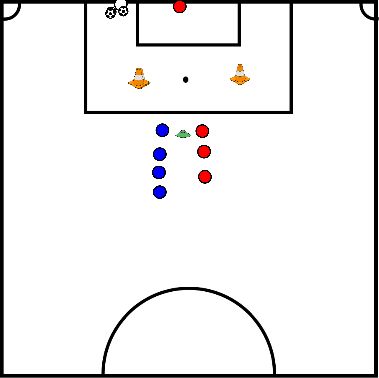
Goal of the exercise is to:
- Pass the ball into the boxes
- Score as many points as possible
- The opposing team's ball may be moved to another box by passing against it with the ball.
- In the youngest groups the distance from the green pawn to the scoring boxes is 5 meters, in the oldest groups it is 8 meters.
- The scoring boxes are 1 meter long and 3 meters wide.









